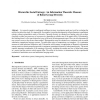1338 search results - page 35 / 268 » Understanding Social Robots |
AROBOTS
2000
13 years 8 months ago
2000
As research expands in multiagent intelligent systems, investigators need new tools for evaluating the artificial societies they study. It is impossible, for example, to correlate ...
ANTSW
2010
Springer
13 years 6 months ago
2010
Springer
Division of labour in multi-robot systems or multi-robot task allocation (MRTA) is a challenging research issue. We propose to solve this MRTA problem using a set of previously pub...
ICRA
2008
IEEE
14 years 3 months ago
2008
IEEE
— In order to provide personalized services and to develop human-like interaction capabilities robots need to recognize their human partner. Face recognition has been studied in ...
IWINAC
2007
Springer
14 years 2 months ago
2007
Springer
Emergent interactions that are expressed by the movements of two agents are discussed in this paper. The common coding principle is used to show how the mirror neuron system may fa...
HRI
2009
ACM
14 years 3 months ago
2009
ACM
This paper proposes a model of approach behavior with which a robot can initiate conversation with people who are walking. We developed the model by learning from the failures in ...

